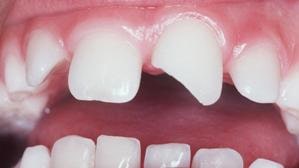Fractured permanent front teeth
If your child has fractured a permanent tooth due to trauma, they will most likely experience sensitivity to hot/cold and pressure.
The severity of the trauma on the tooth will dictate how we will treat it:
A minor fracture with no sensitivity to hot/cold:
We tend to find that most patients could damage a very small edge of their tooth during their day to day activities. For this instance, if cosmetically possible, we recommend smoothing down the fractured edge.

Minor fracture with low sensitivity to hot/cold:
We will give the area around the tooth and the nerve around 5-7 days to calm down before going in and doing a filling.
Fracture with high sensitivity to hot/cold:
If there is no significant soft tissue swelling, we can do a filling. We might place some calming medications on the area to help calm down the nerve. Please see the instructions on deep fillings for more info.
Fracture with an exposed nerve:
Unfortunately, due to the nerve being exposed, we have to recommend a root-canal to ideally treat the tooth and the nerve. How much of the tooth structure was destroyed will dictate how we will restore the tooth.
Vertical fracture of a tooth, limited to the crown area:
We will treat this like the tooth fracture with an exposed nerve. However, the final prognosis is unpredictable, due to the fact that we cannot see the micro-vertical fracture. This can lead us to extract the tooth. We will continue to monitor the tooth and act accordingly.
Visible, vertical, fracture down involving the root:
Unfortunately, this is the worst-case scenario in which we have to recommend extraction. Your child will have a temporary flipper to replace the tooth until they are old enough for implants or placement of a dental bridge.
Read our post on how to prevent sports-related injuries.
Trustindex verifies that the original source of the review is Google. Highly recommend! We've been going here for years now & I never have a complaint!Posted onTrustindex verifies that the original source of the review is Google. If you’re looking for a place that works well with kids I definitely recommend them, the staff is very welcoming and know how to make the visit fun and non scary for the kiddos! My kid leaves this place wanting to go back everytimePosted onTrustindex verifies that the original source of the review is Google. Dr Ngo and team are absolutely great with kids. They go beyond the usual cleaning and talk about jaw, bite, speech and oral health overall. We are grateful to have them local and our kids love going in!Posted onTrustindex verifies that the original source of the review is Google. Me encanta como tratan amos niñosPosted onTrustindex verifies that the original source of the review is Google. Great! took care and kept my daughter calm fast and detailed.Posted onTrustindex verifies that the original source of the review is Google. My son, had a great experience. They were great with my son who is four years old and he felt very comfortable. Great place to take your kids!Posted onTrustindex verifies that the original source of the review is Google. We have been coming to Kid Focus for years and absolutely love it!!!Posted on

